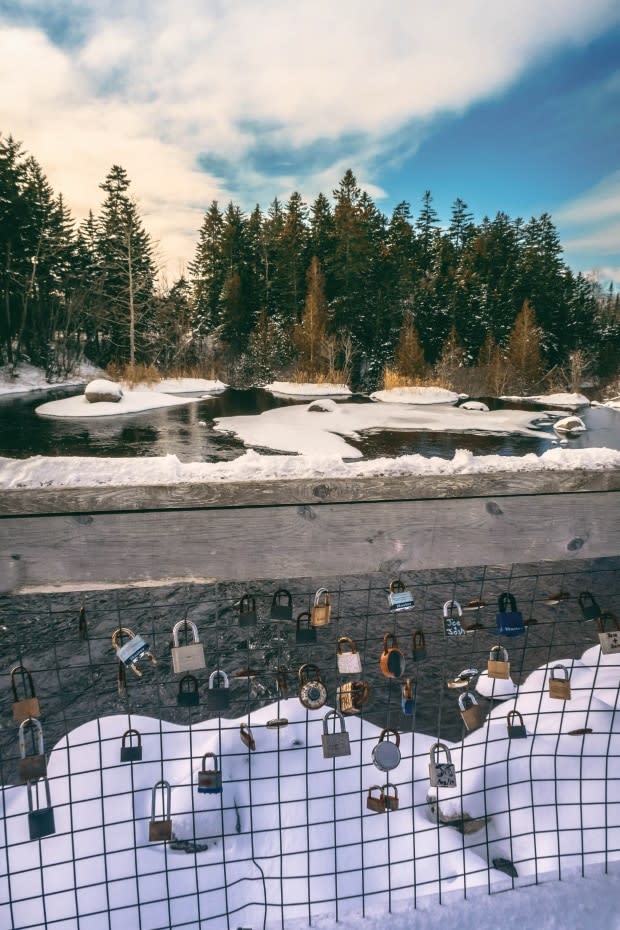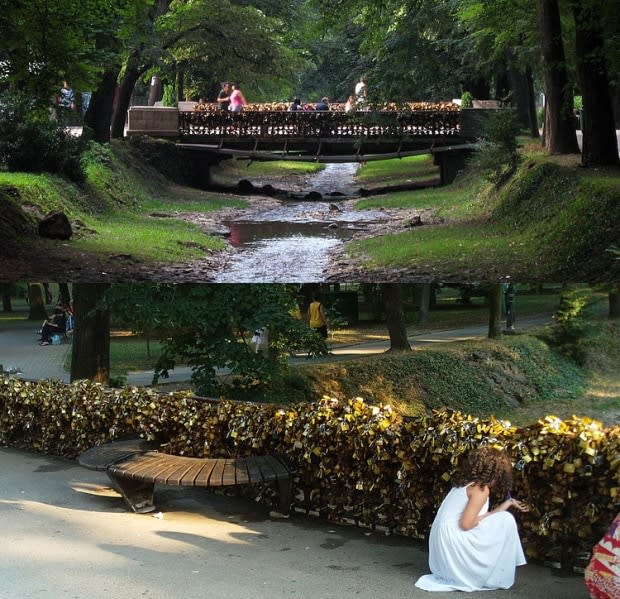Love ritual takes hold in Saint John, but tossed keys a worry to some

While walking through a trail in Little River Reservoir Park in east Saint John, photographer Monique Gionet noticed padlocks of all sizes hanging from the railings of a small bridge.
Initials were scribbled on most them, along with messages like "Jess + Jon" and "Forever + Always."
During the past two years, dozens of locks have been hung on the bridge's railings, according to Gionet. With the growing numbers at the reservoir, people have already begun hanging locks from another bridge, near the city's Lily Lake.
"I really love the sentiment of love locks," Gionet said. "I always have. But it fights the mini environmentalist in me."
During the early 1900s, a common love tale inspired many to hang locks on bridge railings to protect love, or to make it last — even if just for a little longer.
But as the practice spread across the world, love locks have provoked environmental and structural concerns. Some locks have had to be ripped from crumbling bridges such as the Pont des Arts in Paris.

How does it work?
Partners write their initials on locks — some use sharpies while others go for laser technology inscriptions, they hang the locks from bridge railings and throw the keys in the water, while wishing for unbreakable love.
Bridges of cities like Paris, Rome and even Canadian cities like Winnipeg have so many that the clusters of locks resemble flower bouquets.
Gionet had never considered the environmental or structural impact of hanging locks from bridges and throwing keys until she lived in Bristol in 2015 and friends made her aware of the potential environmental and structural impacts.
She also worries about the environmental impact of throwing keys to a body of water.
"What the keys are doing in the water? I don't think it would be good for the environment or the structures the city has put in place."

Love kills
In Saint John, some industries extract water from Silver Falls, one of the two reservoirs at the Little River Reservoir Park, but no water from the park is used for drinking, said Graeme Stewart-Robertson, executive director of the environmental non-profit ACAP Saint John.
"As storybook as it is, we are essentially dumping something into water, which is not only potentially an issue, but it is technically a violation of a couple of different laws," he said of the love lock keys.
Even though most keys aren't made out of anything particularly damaging like lead or arsenic, Stewart-Robertson said some animals that live in or near Little River, including amphibians, reptiles, fish and birds could try to eat the keys.
"It is possible, we have seen this in ducks before, that they will eat a lot of objects that aren't good for them in the process of searching for those that are."
A possible solution
Gionet thinks the City of Saint John should attach a plaque on both ends of the walking bridge asking people not to hang locks or toss the keys in the water.
"It's great for photos, I'll tell you as a photographer. But structurally you can see how [the bridge] is already starting to bend in."
Lisa Caissie, communications manager for the city, said in an email statement that the city is aware of the love locks and has no plan to remove them, as long as people are not damaging the walking bridge.
She said park staff will consider adding a bucket for key disposal or a sign requesting people to pocket their keys.

History of love locks
The Pont des Arts bridge in Paris reached more than 700,000 individual locks, weighing about 45 tonnes, or the combined weight of almost 20 elephants, according to CNN.
The love locks were removed from the bridge that year, the railings replaced with plexiglass coverings, and clusters of about five to 10 locks were sold to the public to raise money for refugees.
But the history of love locks is not Parisian. It is not even French.

The most widely accepted account begins just before the First World War in Serbia, when a school teacher met an officer at a bridge in the small town of Vrnjačka Banja called Most Ljubavi, which translates to the Bridge of Love.
Shortly after they fell in love, the officer went to war in Greece and married a local woman from Corfu. According to the tale, the Serbian woman died alone of a heartache.
Young women from Vrnjačka Banja who heard the tale decided to protect their love by writing their initials and those of their loved ones on padlocks and fixing them to the railings of the bridge where the Serbian school teacher had met her then-lost love.
The ritual became popular yet again around 2006 in Rome with the release of the book I Want You by the Italian author Federico Moccia.
Leave-no-trace philosophy
For Stewart-Robertson, this ritual shows that, in New Brunswick, water sources are often taken for granted because they're everywhere.

"When dozens of people do something, it builds and can have a structural impact or an impact on invertebrates and shore birds. We need to think beyond ourselves," he said.
He thinks people should learn more about what he calls the "leave no trace philosophy," the idea of leaving nothing behind after you visit a green area.
The goal, he says, is to have a net zero impact.
"Or try to leave [green areas] a little better by picking up garbage."
Even if that's not very romantic.


